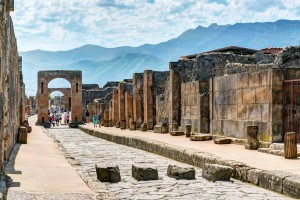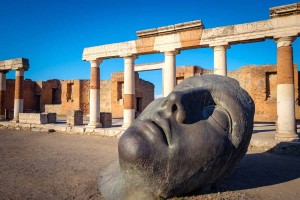
©scaliger
A devastating natural disaster in the year 79 AD laid the foundation for one of the world’s most important cultural and historical research facilities. The eruption of Mount Vesuvius buried the towns Pompei, Oplontis, Herculaneum and Stabiae completely, but the ash largely preserved them. Official excavations only began in the middle of the 18th century unearthing astonishing insights into the life in an ancient Roman city. These days, the archaeological sites of Pompei, Herculaneum and Torre Annunziata at the Gulf of Naples are extremely popular, not just among researchers and historians, and were even declared UNESCO World Heritage in 1997.
Destruction and archaeological history
The date of August 24th stirred intense debates over the last century. While it can be found in letters by Pliny the Younger, other evidence, such as “autumnal” food leftovers in Pompei, would push it back by two months suggesting a transcription error. The sheer scale of the catastrophe, however, is uncontested. A sort of explosion inside the volcanic pipe sent a deadly cloud across the land. Most people either suffocated from the mixture of ash, lava and gasses or were struck by pumice stones raining from the sky. The survivors, such as the Roman writer Pliny the Elder, were later killed by glowing avalanches.
Even though first valuables were recovered shortly after the destruction of Pompei, the area remained untouched for centuries other than very sporadic settlements and some grave robbers. Excavations supervised by the Spanish military engineer Rocque Joaquín de Alcubierre and approved by the King of Naples only started on 6 April 1748. Such operations were halted and resumed numerous times over the following years and decades. Experts initially believed to have found Herculaneum and Stabiae. Research eventually experienced a boom from 1863 onward when Giuseppe Fiorelli was named Soprintendente. Increasingly more modern archaeological technology unearthed more and more buildings, structures and treasures.
Pompei

©Bigstock.com/MartinM303
Even though several areas and facilities are part of this humongous UNESCO World Heritage Site, Pompei is the most famous of them by a long way. We know very much about this ancient city in comparison to others, which is due to the rather well-preserved buildings and a great number of finds – treasures that can now be viewed in museums spread throughout the entire region. But what is it that makes Pompei so spectacular? We know the sites you absolutely have to visit during your tour:
- Forum: A market place first and a meeting place in later years, the forum fulfilled several functions, as buildings from various eras suggest. Inscriptions put its completion around 80 BC, before Pompei was colonised.
- Macellum: Archaeologists and experts still work diligently on the market hall for food on the northern forum site. The macellum was severely destroyed during a brutal earthquake in 62 AD and is currently being reconstructed as true to original as possible. Remnants of fruit and grain, but also of animal and fish bones were found here.
- Capitolium: Dedicated to Jupiter originally, this temple was renovated for Apollo rather soon – a very early adaption to Rome around the mid-2nd century BC. The exposed location and Roman architecture impress to this very day.
- Basilica: As Pompei grew monumentally during the reconstruction of the capitolium for Apollo, this rectangular, three-nave basilica was built as well. It saw the first major use of burnt bricks while stucco gave it a representative look.
- Thermae: Like the private houses, the thermae are known predominantly for their ostentatious, comprehensive frescoes. Many of them were protected extensively after having been excavated and are still in rather excellent conditions. The huge Stabian Thermal Baths are likely the oldest of the city, but you must also visit the Baths of the Forum and the Suburban Baths with their erotic frescoes.
- Temples: We’ve already talked a few temples, but there are way more in Pompei, some of which feature altars with an abundance of frescoes. Forum Triangulare, a massive complex of buildings outside the city centre, features a temple for Hercules and Minerva. The pre-Christian Isis cult particularly left its mark among the regular population, as the Temple of Isis shows. There are also special facilities for Asclepius and Salus, for Venus and for Fortuna.
- Theatres: You’ll probably be surprised to see what excellent condition the theatre facilities of Pompei are in. The large theatre, the Odeion and the first known amphitheatre are very well preserved, indeed. Different architectural styles illustrate the gradual transition from Greek to Roman cultural imprint quite well.
Herculaneum
While Pompei is the best-known of the three archaeological facilities of this UNESCO World Heritage Site by far, you still should visit the other ones. In comparison, there’s fairly little known about Herculaneum, as the ancient town was buried by masses of mud and its buildings were destroyed rather severely. The high cost involved halted all excavation attempts for a very long time. On top of that, armed thieves stole over 250 valuable artefacts in 1990. They remain lost to this day.
Herculaneum lets you take a look inside a few private houses and public buildings. There are also several villas outside the town. Impressive mosaic floors, old statues and artful wall paintings adorn the various facilities. You might even make out a few Roman graffities on house walls here and there. Most of the excavated valuables and pieces of art are not exhibited in the National Archaeological Museum of Naples.
Torre Annunziata
Another place completely buried was the ancient Roman site Oplontis, a few kilometres from Pompei and Herculaneum and now the location of Torre Annunziata. Archaeologists found the villa of a noble Roman family in 1964 and began to excavate it piece by piece. Inscriptions on jugs and amphorae as well as the shape of a statue suggest that the building used to belong to either Nero’s second wife Poppaea Sabina or to her family. The building complex is yet to be excavated completely, but everything that can be seen and explored so far impresses. Countless rooms, a swimming pool, a wine cellar, the orchard and several sycamores attest to the former grandeur.
Pompei, Herculaneum and Torre Annunziata grant insights into ancient Italy like no other site. The fascinating transition from Greek to Roman culture, the excellently preserved facilities, the fascinating art treasures – you’ll live and breathe the spirit of days long gone during a walk through this UNESCO World Heritage Site.